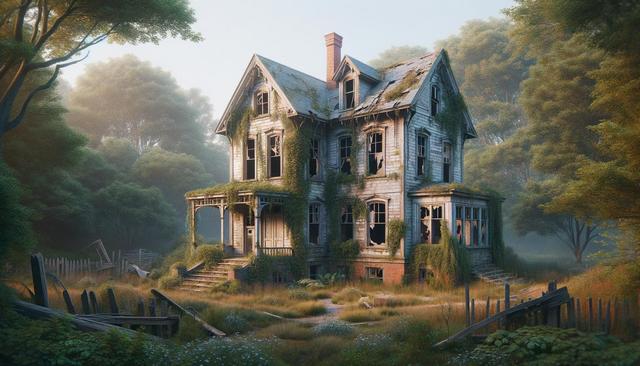Understanding the Fate of Abandoned Houses
When a property is left vacant for an extended period, it typically becomes classified as an abandoned house. These structures can fall into disrepair, posing safety concerns and impacting neighborhood property values. The reasons for abandonment vary and can include foreclosure, death of the owner, or inheritance complications. Once a house is abandoned, it often falls under the jurisdiction of local authorities who must determine next steps. In some cases, the original owner retains rights to the property, but if taxes are unpaid or the house becomes a public safety hazard, municipalities may intervene.
In cities experiencing economic shifts, there’s growing interest in programs that allow individuals to invest in houses for $500 in {city}. These initiatives aim to revitalize neighborhoods by offering low-cost properties under certain conditions, such as committing to renovation plans within a specific timeframe. For those seeking a house to buy, abandoned homes can become opportunities—if they are aware of the legal and financial responsibilities involved.
Legal and Ownership Issues
Determining who owns an abandoned house can be a complex process. In many instances, the title remains with the original owner or their estate, even if the property has been uninhabited for years. However, if the owner cannot be located or has defaulted on property taxes, the house may be subject to tax foreclosure, which transfers ownership to the local government. At that point, the house may be auctioned or included in public housing redevelopment programs.
Potential buyers interested in these homes should consider working with house selling agencies that specialize in distressed or vacant properties. These professionals understand the legal pathways to secure ownership, including:
- Conducting a title search to identify the rightful owner
- Evaluating outstanding debts or liens against the property
- Understanding local regulations on property rehabilitation
For those aiming to invest in houses for $500 in {city}, ensuring legal ownership is the first and most critical step before committing to any purchase or renovation effort.
Challenges of Restoring Abandoned Properties
Restoring an abandoned house can be a rewarding yet demanding project. These properties often suffer from years of neglect, leading to structural issues, outdated systems, and potential health hazards such as mold or asbestos. Before purchasing, it’s essential to conduct a thorough inspection to understand the scope of work required.
Common problems found in abandoned houses include:
- Damaged roofs and foundations
- Broken windows and doors
- Vandalism or theft of fixtures and appliances
- Rodent or insect infestations
Despite these issues, many buyers are drawn to the affordability of such properties. House selling agencies can help connect interested parties with contractors, inspectors, and financial resources to make the project more feasible. Additionally, local governments may offer incentives or grants for revitalizing derelict homes, especially in areas targeted for urban renewal.
Real Estate Investment Potential
Abandoned houses can offer unique opportunities for real estate investors or first-time homebuyers willing to take on a fixer-upper. The low cost of acquisition, particularly through programs that promote options to invest in houses for $500 in {city}, can make these properties financially appealing. However, investors should approach such deals with a clear understanding of renovation costs, local market conditions, and resale potential.
When evaluating a house property for investment, consider the following:
- Neighborhood trends and future development plans
- Availability of skilled labor and materials
- Expected timeline for repairs and occupancy
- Potential rental or resale income
Working with experienced house selling agencies can provide insights into promising areas and guide investors through the acquisition process. These professionals can also assist in navigating zoning laws and permit requirements, ensuring a smoother transition from vacant structure to valuable asset.
Community and Economic Impact
The revitalization of abandoned homes can significantly benefit neighborhoods by improving safety, aesthetics, and economic growth. When left unattended, these properties often attract illegal dumping, vandalism, and squatting, which can deteriorate surrounding house property values. Conversely, restoring an abandoned house can inspire neighboring homeowners to invest in their own properties, contributing to broader community improvements.
Municipalities are increasingly supporting these efforts by offering:
- Tax incentives for rehabilitation projects
- Access to historic preservation funds
- Partnerships with local nonprofits for affordable housing
These initiatives align with long-term urban planning goals and provide a pathway for individuals looking for a house to buy while making a positive community impact. Whether through direct investment or collaboration with house selling agencies, turning an abandoned house into a livable home can be both a personal milestone and a civic contribution.
Conclusion
Abandoned houses present both challenges and opportunities, depending on how they are approached. For individuals interested in finding a house to buy or exploring affordable real estate options, especially through programs that allow them to invest in houses for $500 in {city}, these properties can serve as a gateway into homeownership or real estate development. By working with reputable house selling agencies and understanding the responsibilities tied to house property ownership, buyers can play a role in transforming neglected spaces into valuable community assets. With careful planning and informed decision-making, abandoned houses can become the foundation for meaningful investment and revitalization efforts.




Leave a Reply